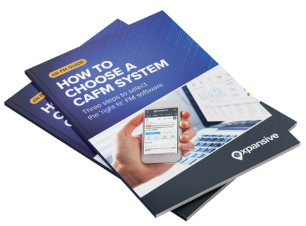When you’re procuring FM or any other kind of SaaS software your IT team are a critical set of gatekeepers who you’ll need to keep on side.
Even though they may have no ultimate role in the implementation of the solution you may still depend on their approval to release budget and get your CAFM project off the ground. The IT team may have overall responsibility for data security, and will likely need to be consulted at some level when it comes to data porting and integration as a solution is installed.
Get IT backing early on
Make sure you seek out their opinion and advice early on as you look for potential CAFM partners - get them on-side with your plan and be sure you know what their questions and possible objections are likely to be.
The IT team are not necessarily decision-makers or budget holders for a piece of FM software, but it's common that they are consulted during the purchase stage and they could have a significant influence on a decision to proceed.
Even with a SaaS purchase, which would not require on-premise installation, the board of directors will still rely heavily on the information and opinion of the IT team about the:
- Functional requirements: Is the software well built, easy to use and include the desired features to deliver upon your objectives?
- Non-functional requirements: Is it accessible across all types of users and devices? Is the performance of the system up to scratch?
- Security: Is the software secure and does the proposed partner have an ISMS framework in place (Information Security Management System)? This will give IT confidence that the businesses information is in good hands.
- Data migration: What are the requirements and how will this be managed?
- Integration: How agnostic is the system and what opportunities are there to communicate to existing systems, mainly finance?
- Support: How will the software and service be supported and what SLA agreements will be in place?
There may well be concerns on the IT side about what IT support they may be expected to provide or the way configuration or data-porting activity may end up devolving to them.
Here are some questions that the IT team will need answering to get them on side with your CAFM plans:
Is the company’s hosting environment secure?
Is the provider’s solution built on a global backbone or a local liability? Is the solution built on leading cloud infrastructures like Microsoft Azure, Amazon Web Services, Digital Ocean or Oracle Cloud? Or does it use local or managed services that can be more unreliable?
What are the SLAs for application uptime and response times in the event of critical issues?
Are they GDPR compliant?
Your chosen supplier should have a clear set of written policies around GDPR - and be able to answer any questions about the way they will control and manage your data.
Does the software offer Multi-Factor Authentication as an additional layer of security?
What does their ISMS (Information Security Management System) look like?
Is your system ISO 27001 certified or, at least, built to the values of the standard? A great ISMS considers not only IT but looks across the entire business operation to ensure cyber and data security. A good ISMS should commit an organisation to continual improvement in these areas, with a plan that looks to
- Ingrain cyber risk management in everything they do,
- Train their workers in best practice
- Continually review process to identify potential gaps in data and cyber-security
- Adapt quickly to new and evolving cyber threats
How is the solution supported - what will your SLAs look like?
The supplier should offer a comprehensive SLA that shows the extent of support offered, speed of response and what work is in scope or out of scope in the project. Your IT team should have sight of these as early as possible to get a sense of what (if anything) they may be prepared to do to support the implementation.
How are integrations handled?
One of the main strategic aims of a business is often to integrate traditionally siloed business systems, to cut down on duplication of work, miscommunication and mistakes between departments. Your IT team will want to know your chosen supplier has an off-the-shelf API for integration for common financial and BMS software. Clearly understanding the timescales, costs and potential limitations for any planned integration projects will give the business full visibility around what is possible. Sharing APIs with your IT team early on will give them confidence that goals can be met with minimal expense and disruption.
What will be the IT dependencies?
If your IT team can be given a demo of the system early on they can get a clear idea of how it will work. With a well designed, user friendly interface the team will quickly have any fears allayed about having to support a sprawling, complex and clunky system.
At the same time, if they get a sense of what the data porting process will look like and are comfortable with the ‘hands on’ support offered by the supplier’s teams, they may be more confident they will not have to wrap up extra IT resource in setting the solution up.
In fact, with the right introduction to the system, the IT team could well begin to see the benefits that a CAFM system can offer over internally supported and ‘patched together’ systems, which are not always fit for purpose.
IT teams will often clearly see the benefit of a SaaS solution that
- Brings all your FM functions under one roof,
- Automates processes
- Opens up reporting and visibility for the whole business.
They will also see the benefits of handing over support for these functions to a reliable supplier, particularly if it releases more of their resource and budget to concentrate on ‘big picture’ strategic projects.
But to do this you’ll have to convince them that the supplier will be a valuable partner and not a potential liability. The right supplier will all have the documentation, technical resources and expertise on hand to help you convince your IT team that you’re making the right decision.




